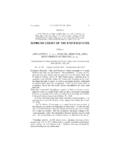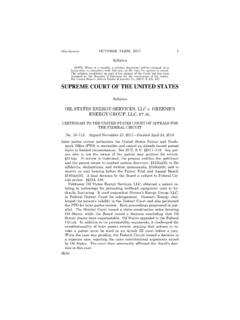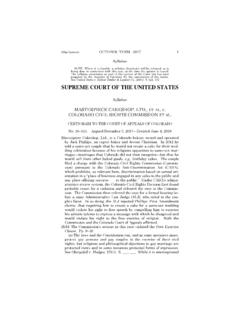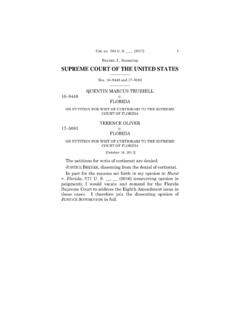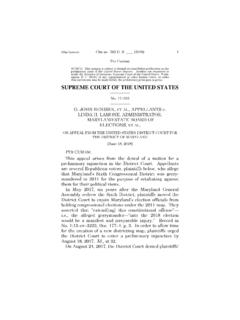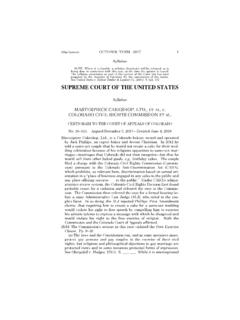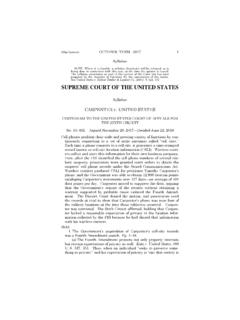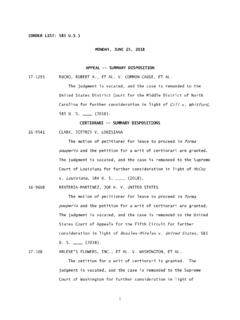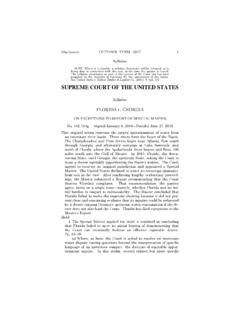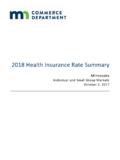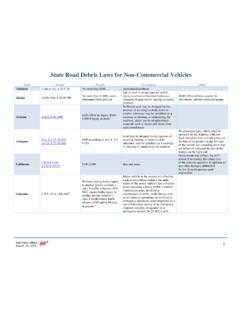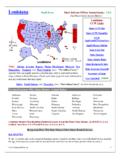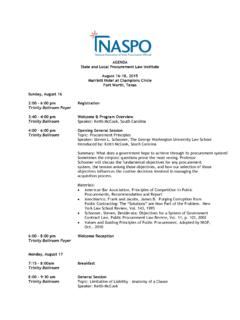Transcription of SUPREME COURT OF THE UNITED STATES
1 1 (Slip Opinion) OCTOBER TERM, 2017 Syllabus NOTE: Where it is feasible, a syllabus (headnote) will be released, as isbeing done in connection with this case, at the time the opinion is syllabus constitutes no part of the opinion of the COURT but has beenprepared by the Reporter of Decisions for the convenience of the reader. See UNITED STATES v. Detroit Timber & Lumber Co., 200 U. S. 321, 337. SUPREME COURT OF THE UNITED STATES Syllabus minnesota VOTERS ALLIANCE ET AL. v. MANSKY ET AL. CERTIORARI TO THE UNITED STATES COURT OF APPEALS FOR THE EIGHTH CIRCUIT No.
2 16 1435. Argued February 28, 2018 Decided June 14, 2018 minnesota law prohibits individuals, including voters, from wearing a political badge, political button, or other political insignia inside a polling place on Election Day. Minn. Stat. (1) (Supp. 2017).This political apparel ban covers articles of clothing and accessories with political insignia upon them. State election judges have the au-thority to decide whether a particular item falls within the ban. Vio-lators are subject to a civil penalty or prosecution for a petty misde-meanor. Days before the November 2010 election, petitioner minnesota Vot-ers Alliance (MVA) and other plaintiffs challenged the ban in Federal District COURT on First Amendment grounds.
3 In response to the law-suit, the State distributed an Election Day Policy to election officials providing guidance on enforcement of the ban. The Election Day Pol-icy specified examples of prohibited apparel to include items display-ing the name of a political party, items displaying the name of a can-didate, items supporting or opposing a ballot question, [i]ssue oriented material designed to influence or impact voting, and [m]aterial promoting a group with recognizable political views. App. to Pet. for Cert. I 1 to I 2. On Election Day, some voters raninto trouble with the ban, including petitioner Andrew Cilek, who al-legedly was turned away from the polls for wearing a Please I.
4 D. Me button and a T-shirt bearing the words Don t Tread on Me anda Tea Party Patriots and the other plaintiffs argued that the ban was unconstitu-tional both on its face and as applied to their particular items of ap-parel. The District COURT granted the State s motion to dismiss, andthe Eighth Circuit affirmed the dismissal of the facial challenge and 2 minnesota VOTERS ALLIANCE v. MANSKY Syllabus remanded the case for further proceedings on the as-applied chal-lenge. The District COURT granted summary judgment to the State onthe as-applied challenge, and the Eighth Circuit affirmed.
5 MVA, Cilek, and petitioner Susan Jeffers (collectively MVA) petitioned forreview of their facial First Amendment claim only. Held: minnesota s political apparel ban violates the Free Speech Clauseof the First Amendment. Pp. 7 19.(a) Because the political apparel ban applies only in a specific loca-tion the interior of a polling place it implicates the COURT s forum based approach for assessing restrictions that the government seeks to place on the use of its property. International Soc. for Krishna Consciousness, Inc. v. Lee, 505 U. S. 672, 678. A polling place inMinnesota qualifies as a nonpublic forum under the COURT s prece-dents.
6 As such it may be subject to content-based restrictions on speech, see, , Cornelius v. NAACP Legal Defense & Ed. Fund, Inc.,473 U. S. 788, 806 811, so long as the restrictions are reasonableand not an effort to suppress expression merely because public offi-cials oppose the speaker s view, Perry Ed. Assn. v. Perry Local Edu-cators Assn., 460 U. S. 37, 46. Because the text of the statute makes no distinction based on the speaker s political persuasion, the ques-tion is whether the apparel ban is reasonable in light of the purposeserved by the forum : voting. Cornelius, 473 U. S., at 806. Pp. 7 9.(b) minnesota s prohibition on political apparel serves a permissi-ble objective.
7 In Burson v. Freeman, 504 U. S. 191, the COURT upheld a Tennessee law imposing a 100-foot zone around polling place en-trances in which no person could solicit votes, distribute campaignmaterials, or display .. campaign posters, signs or other campaignmaterials. 504 U. S., at 193 194 (plurality opinion). In finding that the law withstood even strict scrutiny, the Burson plurality whoseanalysis was endorsed by Justice Scalia s opinion concurring in thejudgment emphasized the problems of fraud, voter intimidation, confusion, and general disorder that had plagued polling places in the past. Against that historical backdrop, the plurality and JusticeScalia upheld Tennessee s determination that a campaign-free zoneoutside the polls was necessary to secure the advantages of the secret ballot and protect the right to vote.
8 MVA argues that Burson considered only active campaigning out-side the polling place by campaign workers and others trying to en-gage voters approaching the polls, while minnesota s ban prohibitspassive self-expression by voters themselves when voting. But alt-hough the plurality and Justice Scalia in Burson did not expresslyaddress the application of the Tennessee law to apparel or consider the interior of the polling place as opposed to its environs the Ten-nessee law swept broadly to ban even the plain display of a cam- 3 Cite as: 585 U.
9 S. ____ (2018) Syllabus paign-related message, and the Burson COURT upheld the law in plurality s conclusion that the State was warranted in designat-ing an area for the voters as their own as they enter the polling place, id., at 210, suggests an interest more significant, not less,within that place. No basis exists for rejecting minnesota s determination that someforms of campaign advocacy should be excluded from the pollingplace in order to set it aside as an island of calm in which voters can peacefully contemplate their choices. Brief for Respondents a vote is a weighty civic act, and the State may reasonablydecide that the interior of the polling place should reflect the distinc-tion between voting and campaigning.
10 And while the COURT has not-ed the nondisruptive nature of expressive apparel in more mundane settings, see, , Board of Airport Comm rs of Los Angeles v. Jews for Jesus, Inc., 482 U. S. 569, 576, those observations do not speak tothe unique context of a polling place on Election Day. Pp. 9 12.(c) But the line the State draws must be reasonable. The State therefore must be able to articulate some sensible basis for distin-guishing what may come in from what must stay out. The unmoored use of the term political in the minnesota law, combined with hap-hazard interpretations the State has provided in official guidance and representations to this COURT , cause minnesota s restriction to fail this test.
